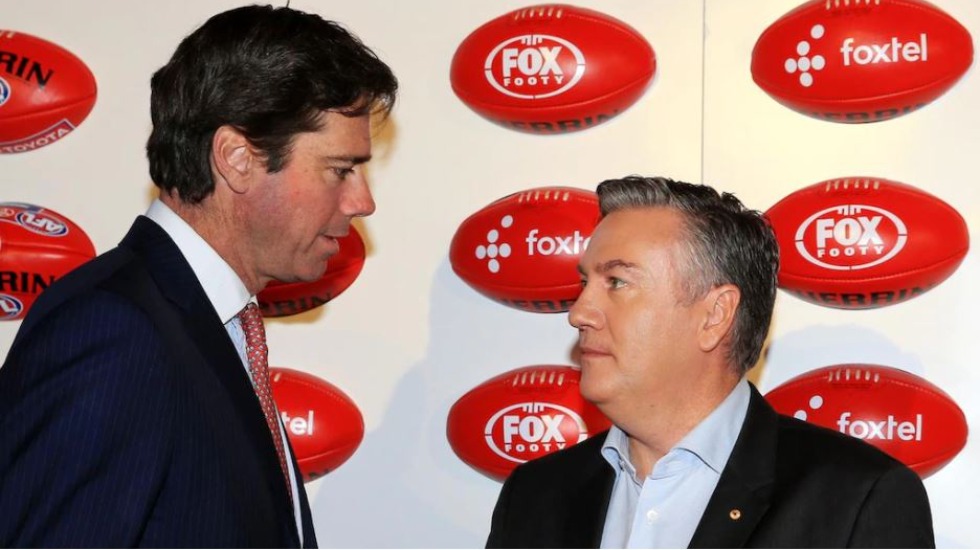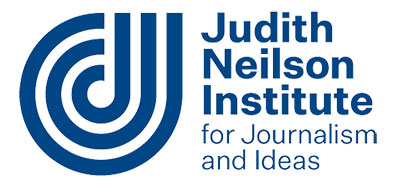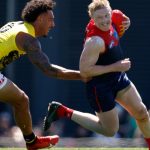Eddie McGuire mightn’t have an official role within the AFL anymore, but he retains considerable influence. Photo: AFL MEDIA
Perception, we’re often told, is reality. For two decades, Collingwood president Eddie “Everywhere” McGuire has appeared the most-powerful man in Australian football. More so than the AFL Commission chairman, currently the low-key Richard Goyder.
To quote former Sydney Football Club chairman Richard Colless from Footyology (Janaury 19 this year): “I can’t tell you how much (of McGuire’s perceived power against the AFL Commission) is real.
“But when you have an AFL writer (Ashley Browne) put together an annual list of the 50 most powerful people in the game to be published on an AFL platform and the Collingwood president is at No.2 and the AFL Commission chairman (Richard Goyder) is at No.3, what more do you need as a statement on Eddie’s power and influence.”
For the record, Browne – who this year ranked Goyder at No.4 and McGuire at No.10 – says he doubts McGuire “has ever made it higher than Nos. 4 or 5 though”.
And this was when McGuire was a club president at one of the league’s biggest clubs, a multi-media personality with top-rating shows and a man with such notoriety that he could be identified simply by his first name.
Now Ed is without an official role at Collingwood and he has scaled back his media profile, but still there is the perception he has more power than the AFL commander, Mr Goyder.
Today, this perception will appear reality if McGuire – while holding no official office in clubland – continues to spook the AFL executive and AFL Commission in a saga that has no limit in its ability to defy logic.
Port Adelaide wants to wear its traditional black-and-white bars twice a year in Showdown derbies with Adelaide at Adelaide Oval. This is the AFL equivalent of ABC Radio’s long-running “Blue Hills” soap opera.
And each year, as the issue is reheated with more gas than used on the leftovers from the Sunday roast, McGuire comes up with a new theme to block Port Adelaide.
To the unaffected, the fans of the other 16 AFL clubs, the issue has become a tiresome reminder of how Eddie appears to command more power than the AFL Commission chairman.
He still seems to speak as if he was a club president …
Port Adelaide premiership captain Warren Tredrea wrote in response to McGuire’s latest tirade from the set of Footy Classified: “As much as Eddie is kicking up dust, this isn’t his decision – it’s ultimately the AFL’s call.
“The AFL are the ones who own all club colours, designs, emblems and trademarks of the guernseys, not the clubs themselves – so it is they who must have the final say.
“Unfortunately, the AFL more often than not chooses to govern by sitting back and waiting for the two parties – in this case Port Adelaide and Collingwood – to come to an amicable outcome,” concluded Tredrea on his blog site warrentredrea.com
This is not the way the “founding fathers” of the national league envisioned the VFL-AFL Commission to operate when it was established in the mid-1980s.
Colless told Footyology in January: “In the history of the game, the VFL was repeatedly subject to the power and influence of some (club-based) individuals. But for the past 35 years we have had an independent AFL Commission … and still one club president appears capable of having more influence on decisions than the game’s appointed leaders.”
It is not a good look, particularly for Goyder when McGuire no longer has an invite to bang his fist on the big rectangular table in the first-floor executive meeting room at AFL House but can command debates from a television studio.
What if McGuire, while commanding a soap box each Wednesday night on Channel Nine’s Footy Classified, proves to be just as powerful without wearing the hat assigned to the Collingwood Football Club president?
There is also the supplementary question: Why does former Victorian Premier Jeff Kennett in his second outspoken stint as Hawthorn Football Club president not rattle the AFL Commission in the same way McGuire does? Perhaps he does not need to when his premiership-winning coach Alastair Clarkson appears to command power at AFL House.
So what if Port Adelaide did wear black-and-white bars for two derbies in Adelaide each AFL season? Would it – as McGuire now argues – diminish the value of the Collingwood black-and-white stripes that Ed says make up the most-valuable cloth in Australian sport (supposedly more than the cream linen worn by the Australian Test cricket team)?
Would international corporate houses seek refunds on their mega-sponsorship deals at Collingwood because another AFL club wears black-and-white twice a year, outside of the Victorian market? No. Sponsors align their brands and logos with Collingwood to appeal to its large supporter base – not because it wears black-and-white stripes.
Will Collingwood sell less merchandise? No. It is hard to imagine a Collingwood supporter giving up on a Collingwood guernsey to buy the Showdown jumper from Port Adelaide. Or any guernsey from any rival AFL club.
But Eddie persists and the AFL avoids ending the issue, enhancing the perception that McGuire has more power than the AFL Commission chairman.
PLEASE HELP US CONTINUE TO THRIVE BY BECOMING AN OFFICIAL FOOTYOLOGY PATRON. JUST CLICK THIS LINK.
While on this theme. WHAT IF …
THE “stand rule” at the mark did not apply inside the forward 50?
The image of defenders manning the mark like scarecrows – fearing a 50-metre penalty and conceding a goal if they exhale over the mark – while their opponents swing on an arc to get five metres closer to goal looks so, so wrong.
PATRICK Dangerfield had been concussed rather than Adelaide defender Jake Kelly in that Round 1 head clash at Adelaide Oval that supposedly put the last nail in the coffin of the bump? Or if both players were concussed?
It is very clear the AFL match review officer Michael Christian will hold players accountable for the consequences of their actions on the field, even those split-second bumps that were once key parts of the game’s marketing to emphasise Australian football was a tough game. Dangerfield copped three games in Round 1; Christian remained consistent by handing Greater Western Sydney defender Sam Reid two matches in Round 2 for his bump on Brownlow Medallist Nat Fyfe, excusing the Giant’s bump as “high” in impact rather than “severe” as in Dangerfield’s case.
Now, quite appropriately, the AFL has to consider the legal risk the game faces from retired players – taking advice from well-briefed lawyers – questioning if their recurring headaches, depression and fading memory issues are related to knocks taken to their heads on the football field rather than naturally from the passing of time.
As much as the old guard moans whenever Christian deliverers his MRO verdicts, the landscape has changed – and, basically, for good reason.
AFTER the COVID vaccine roll-out, the AFL clubs have full capacity restored to all venues … and the fans still stay away, as noted at Adelaide Oval and the MCG, particularly with the Carlton-Collingwood blockbuster derby in Round 2 (75 percent capacity; 50 per cent uptake by the fans)?
Despite AFL football boss Steve Hocking’s tinkering with the rules to encourage more attacking football in more space, the fans have stayed home … and might have developed new habits in front of those big-screen televisions they bought while Harvey Norman bombarded Australia with saturation advertising during the COVID lockdowns.
HOCKING picks up the advice of former Geelong team-mate and current Port Adelaide coach Ken Hinkley to shorten the day/night out at the footy?
“My personal opinion,” says Hinkley, “the game is too long; it has gone back to being too long.
“… the game is a little bit too long for the way we are asking the players to play. As fatigue sets in, the spectacle becomes less.
“Sixteen minutes was too quick. There was some noise about 18; for me it would have been okay at 18. With 75 rotations, the spectacle becomes a bit of a challenge in those last 10 minutes if the game is done and dusted.”
It will not be the commercial breaks between goals that are shortened.
THURSDAY night team selection was restored?
How do you feel about filling out the tipping sheet at your office or pub when there is no team line-ups to study? The end of the Thursday night ritual of reviewing the ins and outs – not just for tipping but also to see how your beloved team will line-up – was understandable during the COVID-condensed 2020 season.
But why did the routine not return for this AFL season? The obligation on the 18 AFL clubs to be more transparent with their injury reports is even more compelling today.
TASMANIA does get an AFL team soon. How would the old guard of Tasmanian football feel if this team – made up of drafted talent from all Australian States and territories and perhaps some international ports – wore Tasmania’s famous “map” guernsey designed for State games?
Brownlow and Magarey Medallist John Platten, among other South Australian greats, declared only “over my dead body” would he allow the Adelaide Football Club wear South Australia’s red State jumper in an AFL club match during a now-lost “heritage round”. The SANFL, after first approving the jumper be worn by the Crows, revoked the permission amid significant outrage – and declared the jumper could only be worn by State teams.
How would the debate play out in Tasmania?
THERE was a bye before the AFL grand final rather than during the weekend between the end of the home-and-away and top-eight finals series?
There are the questions of how much has the pre-finals bye diluted the advantage that should be carried by the top-two teams during the major round – and do the top-two teams get too much rest in September.
Kim Crawford, the man seeking acknowledgement for redesigning the AFL/NRL top-eight finals systems, told Footyology last month: “I don’t like (the pre-finals bye). It is not a good idea (for the way the race to the AFL premiership plays out across the month-long major round). If the top-two teams win in the first week, they are not playing much football – not enough football – during that month. They can struggle to maintain the momentum they took into the finals.”
An AFL club best-and-fairest champion (who is quite happy for the debate to not carry his name) suggests the league move the bye to the weekend after the preliminary finals. This would put the AFL in line (once again) with American football’s NFL that has a bye between the championship play-offs and the grand finale Super Bowl.
But this recommendation is not about once again copying US professional sports but easing a potential cruel blow from the AFL’s new concussion protocols that demand a mandatory 12-day break for any player suffering concussion in play, training or (as in St Kilda forward Max King’s case) golf.
To quote the player: “Been debating this with so many people … I wonder if the AFL have thought about moving the bye at the start of the finals to after the preliminary finals in case someone gets concussed, to give him enough time to recover to play in a grand final? Would be ugly if star players were concussed in a preliminary and missed a grand because the AFL put a rule without thinking about other consequences ….”
The counter argument will be many players in the past would have savoured the blessing of an extra week’s recovery to overcome injury that cost them grand finals starts.
Perhaps this reloads the question, what if every player in a club’s squad was honoured with a premiership medal?













Really interesting piece. Poses some very interesting ideas without enforcing an opinion on the readers. For what it is worth, would prefer bye before GF as opposed to start of finals.
The week for the Grand Finalists to prepare is excellent, the Brownlow could be on the Saturday night, the state women’s leagues premiers could have a mini carnival.
Also the two competing teams should be housed in a hotel for grand final week. The playing list plus the necessary staff all stay away from home for the week, even Melbourne based teams stay in the hotel.
It would allow an interstate team to acclimatise better, it would reduce the travel pressure, it would allow the press greater access to players, coaches, and officials of the competing teams.